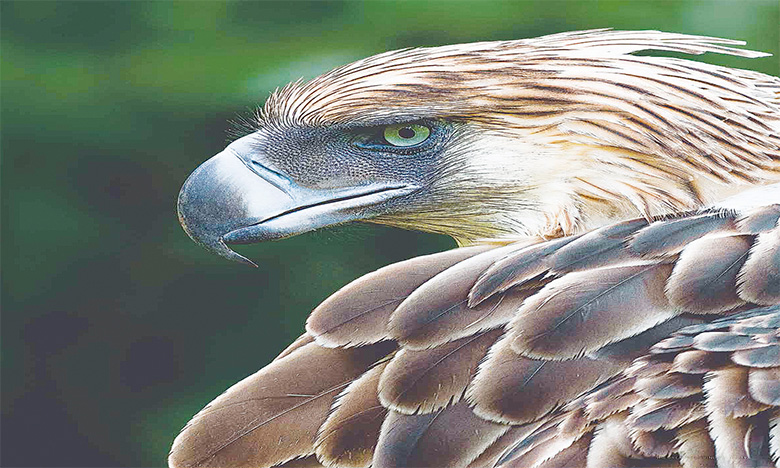Nature lovers enthralled by our very own Philippine Eagle for being one of the world’s most beautiful and majestic creatures will welcome the recent launching at the National Museum of the coffee table book, Haring Ibon – The Great Philippine Eagle by Alain Pascua, co-founder of the Wild Bird Photographers of the Philippines, Inc. (WBPP), and concurrently Undersecretary of Education for Administration.
The author’s photographs of wild birds have graced numerous local and international publications and fora including an exhibit at the National Museum entitled Birds and Climate Change.
Recently, his photographs were featured in the newly published books Owls of the World, A Photographic Guide by Heimo Mikkola, and Woodpeckers of the World, A Complete Guide by Gerald Gorman. The photographs also graced the banner masthead and the bird section of the EDGE of Existence website of the Zoological Society of London, the only global conservation initiative to focus specifically on threatened species that represent a significant amount of unique evolutionary history.
Pascua is deeply involved in conservation and part of the global team of wildlife authors and photographers of the Focusing on Wildlife website at www.focusingonwildlife.com whose mission is to promote wildlife conservation by changing attitudes towards nature and helping people imagine wildlife and humans living in harmony. He is one of the Species Champions of the website.
President Rodrigo Roa Duterte, otherwise not known for penning book reviews, insightfully writes on the first page of Haring Ibon, “This coffee table book provides us with a glimpse of the dramatic daily journey of one of the world’s rarest and critically endangered birds. It brings us to the wonderful settings that virtually give the readers a sense of adventure and an almost real-life experience of how these eagles exist in the wild. May this publication successfully showcase your artistic ideas and unique skills in photography as well as your efforts to portray the plight of the Philippine eagles.”
Meanwhile, Dr. Angel C. Alcala, Ramon Magsaysay Awardee and National Scientist, writes in the book’s preface, “Although the Philippine Eagle has been written about in several articles and books, this is the first time that the magnificent bird is given prominence in a whole book through documentation – with more than 100 photographs of the eagle’s breeding biology and early life history in its natural nesting site at Mt. Apo Natural Park. The major focus of many of these pictures was the nesting site and environs (the original eagle habitat) at Mt. Apo and the early development of the eaglet Sinabadan in the nest.” Sinabadan means unity in the dialect of the Bagobo Tagabawa tribe which plays an important role in the conservation of our National Bird.”
The Philippine Eagle is the largest eagle in the world, standing at three feet or roughly a meter tall with a wingspan of about seven feet. Its presence has been documented in Luzon, in Leyte and Samar in the Visayas, and in Mindanao. The only bird of prey with blue-gray eyes, it is further distinguished by its head crest of brown and white feathers which it can raise or lower at will.
The first ever sighting of the Philippine Eagle was recorded in 1896 in Paranas, Samar by John Whitehead who called it Pithecophaga jefferyi or Monkey-eating Eagle. In 1965, wildlife biologist Dioscoro S. Rabor called the world’s attention to the eagle’s dwindling population. A year later, President Ferdinand E. Marcos declared it protected species. He established a conservation program for the bird in 1969 and renamed it the Philippine Eagle in 1978. President Fidel V. Ramos proclaimed it the National Bird of the Philippines in 1995. In 1999, President Joseph Ejercito Estrada declared the fourth to the tenth of June every year as Philippine Eagle Week to instill the importance of the bird as a biological indicator of the forest ecosystems, as a national symbol, and as a unique living element of the country’s heritage.
Flying on top of the food chain as one of the most powerful birds in the world, the Philippine Eagle preys on monkeys, lemurs, civets, bats, rats, monitor lizards, snakes, squirrels, birds, deer, boars, pigs, and chickens. Its beaks and claws are strong enough to carry and rip wide open its prey’s carcass.
The Philippine Eagle is one of the world’s most rare raptors, critically endangered because of the continuing loss of its natural habitat (the country’s old growth forests) and hunting, an activity that remains rampant and unchecked even while it is illegal. According to the Philippine Eagle Foundation, there are no more than 400 pairs of Philippine Eagles remaining in the wild. Inherently territorial, these birds keep their borders exclusive to their families to the extent of engaging in fierce battles with any eagle that may enter or encroach on their territory. The few eaglets that survive nature and man are sometimes lost, too, some orphaned or killed during these territorial disputes.
Even if present forest cover is maintained, the National Bird will remain critically endangered species, as its heirs will not have adequate territory to rule. It is of utmost importance, therefore, to increase the forest cover; protect the remaining virgin and old growth forests from any incursions; and reclaim, regrow, and expand buffer zones and coverage. Only then, with our intervention, can the Philippine Eagle surmount its critical condition. But all that is a tall order.
Nonetheless, befitting the times, the coffee table book, Haring Ibon – The Great Philippine Eagle, celebrates this gift of nature as a unifying symbol of the Filipino nation’s aspiration to soar to greatness.
For more information on Haring Ibon – The Great Philippine Eagle, visit www.haringibon.com or email This email address is being protected from spambots. You need JavaScript enabled to view it..

